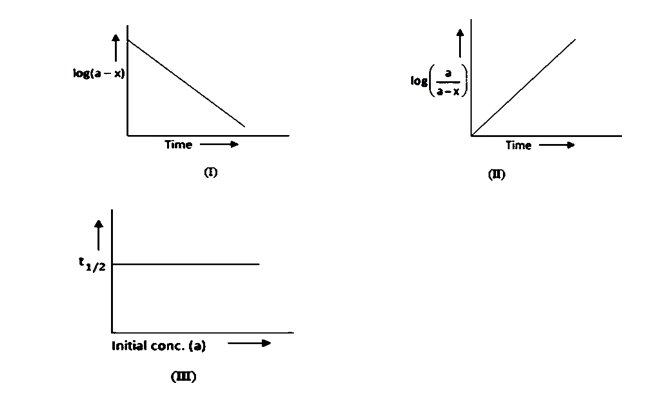The initial concentration of the reactant in a first order reaction is a . It takes time t for the completion of noth fraction of the reaction. Will it take time 2t for the completion of the same fraction if the initial concentration of the reactant is made twice ? Solution in Bengali
Let , time taken to complete fraction of the reaction is t.
Again, time taken to complete fraction of the reaction is if concentration is 2a.
Thus, the time required for a first order reaction to complete a certain fraction of the initial concentration, does not depend on the substrate concentration . In both the cases where the initial concentrations are a and 2a respectively , time required is same .
Topper's Solved these Questions
- CHEMICAL KINETICSBook:CHHAYA PUBLICATIONChapter:CHEMICAL KINETICSExercise:QUESTION-ANSWER ZONE FOR BOARD EXAMINATION (VERY SHORT ANSWER TYPE)
Explore 35 Videos
- CHEMICAL KINETICSBook:CHHAYA PUBLICATIONChapter:CHEMICAL KINETICSExercise:SOLVED WBCHSE SCANNER (2014)
Explore 3 Videos
- CHEMICAL KINETICSBook:CHHAYA PUBLICATIONChapter:CHEMICAL KINETICSExercise:EXERCISE (NUMERICAL PROBLEMS)
Explore 37 Videos
- BIOMOLECULESBook:CHHAYA PUBLICATIONChapter:BIOMOLECULESExercise:Practic Set 29
Explore 1 Video
- CHEMICAL THERMODYNAMICSBook:CHHAYA PUBLICATIONChapter:CHEMICAL THERMODYNAMICSExercise:Practice Set 6
Explore 15 Videos
Similar Questions
For the reaction 12A2+32B2→AB3, express the rate in terms of decrease in concentration of the reactants and increase in concentration of the product.
View Solution50% of a first order reaction gets completed in 10 min. What fraction of reactant of the above reaction would remain after 20min ?
View Solution2A→4B+D , in this reaction, concentration of B increases to 2×10−3mol.L−1 after 10s from the start of the reaction . Calculate : rate of formation of B
View SolutionWrite down the structure of tripeptide Gly-Ala-Val.
View SolutionThe condition for spontaneity of process is
View SolutionIf 'a' is the initial concentration of the reactant, the time taken for completion of the reaction, if it is of zero order, will be
View SolutionHow does the initial concentration of the reactant in a first order reaction very with time ?
View SolutionShow that the time of a first order reaction takes for 'the nth' fraction of the initial concentration of its reactant to converted into product does not depend on the initial concentration of the reactant.
View SolutionPlot a graph of concentration of a reactant at time t, [ (a-x)] against time for a first order reaction .Here a = initial concentration of the reactant an x = change in concentration of the reactant at any time 1 during the reaction.
View SolutionWhich of the following is/are correct for the first order reaction ? (a is initial concentration of reactant, x is concentration of the reactant reacted and t is time)

View SolutionC_(o) =initial concentration of the reactant C_(t) = concentration of the reactant at time t, k=rate constant of the reaction. Then the equation applicable for a first order reaction is
View SolutionFor a first order reaction, if ‘a’ is the initial concentration of reactant, then the half life time is
View SolutionIf a is the initial concentration of the reactant, the time taken for completion of the reaction if it is of zero order will be
View SolutionIf a is the initial concentration of the reactant, the time taken for completion of the reaction if it is of zero order will be
View SolutionWhich of the following graphs represent a first order reaction (a=initial concentration of reactant, x=concentration of reactant consumed, t=time)
View Solution
